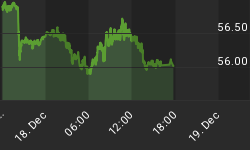Fourth quarter GDP was revised higher to 1.6% from 1.1% estimated last month. The largest revisions were in inventories and higher corporate spending. Business fixed investment increased 5.4%, compared to earlier estimates of 2.8%, driven by a larger increase in purchases of equipment and software, which was up 6.2% compare to earlier estimate of 3.5%. Government spending was also revised higher. Instead of dropping 2.7%, it rose 0.7%. Residential construction grew less than first reported. It grew by 2.6% compared to 3.5% as first reported. Three weeks ago, economists expected first quarter GDP to increase by 4.0% according to a survey conducted by Bloomberg. Over the past few weeks economists have been ratcheting up estimates and likely stand much closer to 5.0%.
New home sales fell in January to a 1.233 million unit pace. This was down from a revised 1.298 million pace in December and was the slowest pace since January last year. Additionally, the number of homes for sales jumped to 528,000. This is 2.5% higher than last month and 21% higher than last January. The Northeast experienced the largest drop in sales, 14.9%, while the West was the strongest. Sales were up 11.3% in January and up 16% year-over-year in the Western part of the country.
Existing home sales fell 2.8% in January from the previous month to a 6.56 million unit pace. This was 5.5% lower than last January and the slowest pace since February 2004. The number of homes for sale increased to 2.914 million units, just shy of the record set in November of 2.924 million. The drop in sales pushed the months of supply to 5.3 months, the highest since August 1998. The median price of existing homes rose 12%. This is similar to the 13% increase that OFHEO reported was the average house price appreciation last year.
Auto sales in February dropped to an annualized rate of 16.6 million units. This was slightly higher than analysts expected and was one million units lower than last month. While auto sales were generally robust in February, the domestics continued to lose market share. Sales of Ford vehicles dropped 4% and General Motors suffered a 2.5% decline. GM's new GMT 900 line helped it posts an increase in truck sales (up 5%) but its sales of cars dropped 13%. Sales at Ford were just the opposite as Ford has shifted its focus on selling cars. Ford's sales were boosted by an 11% increase in fleet sales. Both automakers announced cuts in second quarter production. Ford will reduce production by 1.8% and GM will cut the number of vehicles it manufactures by 3.7%. Both these companies desperately need to pump out as many cars as possible to spread out their enormous fixed costs. Market share of the domestic automakers dropped 1.2% from last February to 56.7%. Honda led the Asian automakers with an 8.7% increase. Toyota and Nissan increased sales by 2.4% and 2.2%, respectively. Volkswagen (sales up 21%) and Porsche (up 19%) were the two leading European nameplates.
The manufacturing ISM rose 1.9 points to 56.7 in February. Orders increased 3.9 points to 61.9. It was the first time orders were over 60 since December 2004. The index for consumer inventories rose to 48.5 in February. While it remains under 50, which means suppliers think their customers' inventories are too low, it tied as the highest reading since the survey started in August 2001. It is easy to assume that suppliers would want to think their customers need more of their goods, so the fact this has historically been under 50 should not be a surprise. Now, suppliers feel that their customers' inventories are higher than in the past. This happened while new orders reached a fourteen month high. It appears that purchasing managers are optimistic about the future. While the national PMI survey advanced, the Chicago PMI dropped to 54.9 from 58.5 in February. This is likely a reflection of the weakness in the domestic automakers. Forty percent of the nation's auto output comes from the Chicago region.
Consumer confidence fell 5.1 points to 101.7 in February. The decline was entirely due to lower expectations. The present situation index rose 0.5 points to 129.3, which was the highest since August 2001. More people felt that jobs were plentiful than in over four years. However, the number expecting income to increase dropped for the second consecutive month. Personal income has been increasing at a healthy pace over the past year, but has started to trend down over the past few months. Personal income growth had risen by over 6.0% on a year over year basis every month between October 2004 and April 2005. Since then, income increased by 6.0% or more in only four of the past nine month, and any in the past three months. With housing prices slowing, consumers will have to rely more on income growth to continue current spending habits. The savings rate continued to be negative in January and it has been zero or below for ten consecutive months.
By most accounts the economy has bounced back from the weak pace in the fourth quarter. For the past several years, residential construction has provided a significant stimulant to economic growth. During the fourth quarter, its contribution was not much more than the overall growth of the economy and the anecdotal evidence shows that it has not gained any strength during the first quarter. With household balance sheets heavily weighted in housing and saddled with a significant amount of debt, there is a good chance that once the consumer starts to stumble, economic growth will deteriorate rapidly.















